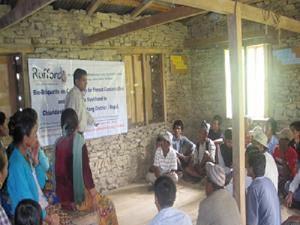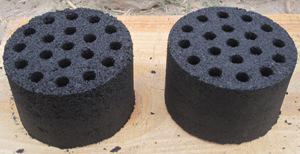Kumar Luitel
Other projects
14 Aug 2012
Promotion of Briquette Technology for Forest Conservation and Sustainable Livelihood in Khotang District
The project aims to conserve the forest by enhancing the capacities of the targeted community members as well as improving their livelihood status by using local resources.

Mr. Luitel is conducting a training on forest conservation.
Khotang is one of the remote hill districts of eastern Nepal. Rapid deforestation for the fuel wood is the root problem of the proposed Chiuridanda VDC of Khotang district. On the other hand, Eupatorium adenophorum, the shrubby perennial, is known as Banmara “the forest killer” in Nepali due to its notorious action in preventing other seedlings to grow. This shrub is found gregariously in the proposed and often nuisance to the villagers. The “Bio-Briquette on Community for Forest conservation and sustainable livelihood in Chiuridanda VDC in Khotang district” /Nepal project has aimed to harvest this shrub not only to make briquette from the shrub but also to restore the forest. The cleaning of Banmara from the forest will be simultaneously carried out making rooms for other species to regenerate. The project will initiate to manufacture briquette involving community people and also explore market in the district headquarter. This initiative will also discourage the use of cow-dung cake in cooking, which has greater soil fertility value. Instead, the farmers will use briquette as the source of fuel wood and additional income.

Farmers participation on Cooking Stove making Training(Briquette Technology)
Rural Energy policy 2006 of Government of Nepal has clearly stated and emphasized in the use of rural energy and its alternatives for the betterment of local people and surrounding environment. Moreover it has also emphasized in the use of bio energy at household level as alternative and efficient means of energy, which could help in reducing carbon emission and dependency in the natural resources for conventional fuels. Activities and programs featured with this aims are highly encouraged and supported, as they are means to cope current environment problems. Alternative Energy Promotion Centre (AEPC under the Ministry of Environment, Science and Technology (MoEST) has also addressed and introduced biomass briquetting to meet the energy deficit, to raise living standards of the rural people and to conserve the nature.

Drying of Briquettes after production.
Nepal is one of the highest traditional biomass energy consumption countries in the world as 80% of population depend on dry fuels, mostly firewood for cooking and heating purpose. The increasing demand for fuel wood in rural areas of Nepal like proposed VDC poses a serious threat to the nature. The loss of biodiversity, soil fertility and degradation of watersheds are some of the visible impacts of the deforestation. In order to tackle these problems, identification and promotion of alternative low cost and sustainable energy sources is the basic need of the community, especially in rural areas. Compact mass of charred biomass and clay, known as bio-briquette is one of such alternative energies. It does not only prevent deforestation but also provides an ample income generation opportunity for the rural communities.